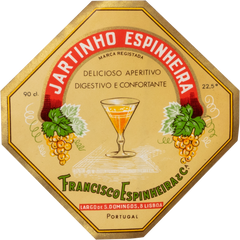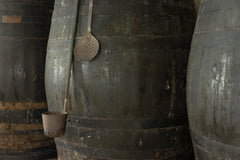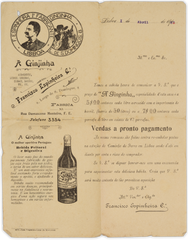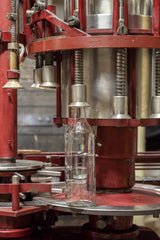History

1840
Our roots go back to the tavern that operated at No. 27, Rua das Portas de Santo Antão, a place well alive at the time, according to Lisbon mid-XIX century folklore. Our oldest factory was set there, and that is where the wines and liqueurs that we now understand as Ginjinha’s ancestors were produced, sold, and celebrated.
Largo de São Domingos. Horácio Novais Studio, FCG-Art Library.
Among these, we count precious gems like the “Anis Escarchado”, the “Aguardente Aniz Superior”, the “Granito” digestif, the “Licor de Cardomomo Superior” or even the “Jartinho Espinheira” apéritif.
Labels of various beverages produced and sold.
Sales notebook from April 1907.
1910
Francisco Espiñeira Couziño had seen his father turn the No. 27 tavern not just into a profitable business but also into a space for the sharing of ideas and social agitation. And plenty of romances and quarrels, if we’re being honest.
Portrait of the founder, Francisco Espiñeira Couziño, that has always been at the store's entrance in Largo de São Domingos, Lisbon.
This was likely the scenario that awakened his desire to engage in the production of his own liqueurs, leading him to found the company that we still run today. In addition to what the labels that withstood the friction of time tell us, there are also records of refurbishment work done in our current store, the picturesque “A Ginjinha” in Largo de São Domingos, dating back to 1910. This undertaking took place at the hands of Francisco Espiñeira Couziño — the man we look up to as the first driving force behind Ginja Espinheira.
Largo de São Domingos A Ginjinha, is located on the left building. Horácio Novais, in F.C.G.
It was out of this location that the ritual of “drinking a Ginjinha” became a staple of the Lisbon lifestyle, growing into a habit shared by all classes and almost all ages.
Just ask the shoe shiners at Largo de São Domingos, who have been finding their clients right at our doorsteps for decades.
Shoe shiners at Largo de São Domingos.
Original paintings that decorated Ginjinha in Largo de São Domingos.
1919
With the 1920s just around the corner, the construction of our factory in Rua Damasceno Monteiro ensues, and it eventually replaces the original production space on Rua das Portas de Santo Antão. Many of the oak casks that still sit there as living memories date back to this time.
Front of a postcard from A Ginjinha.
Front of a postcard from A Ginjinha.
Back of a postcard from A Ginjinha.
1920—1932
The first exports of our products occurred during this period, primarily to the former Portuguese colonies.
Official pricing document.
Former United States importer seal.
It was also within this time frame that Ginja Espinheira was awarded three Gold and two Silver Medals at the International Exhibitions of 1923 (Rio de Janeiro), 1926 (Macau), 1929 (Seville), 1929 (Barcelona), and 1932 (Portugal).
Seal stamp from former importer in the United States of America.
These distinctions recognised the quality of Ginjinha on a grander scale but, according to some testimonies, were more a source of pride than amazement for the loyal local consumers.
Gold Medal from Rio de Janeiro International Exhibition, 1923.
Silver Medal from Barcelona International Exhibition, 1926.
Gold Medal from Seville International Exhibition, 1929.
Gold Medal from Portugal International Exhibition, 1929.
1932
Miguel Osvaldo Espiñeira would also be born in this year, a figure who in the following decades would be responsible for making Ginja Espinheira an even more entrenched tradition, not just in Portugal but throughout the world.
Miguel Osvaldo would be the one to advance with the mechanisation of the factory on Rua Damasceno Monteiro and, realising the advantages of self-sufficiency, acquire 25 hectares of land in Arruda dos Vinhos. It is precisely in this blessed place that our orchard grows to this day and where our production facilities now operate from.
Bottle filling machine from the former factory on Rua Damasceno Monteiro.
Nowadays
Orchard and factory where the A Ginjinha liqueur is currently produced.
As was the wish of the parents of Ginja Espinheira, the company remains a family project.
Thanks to Lojas com História for all the support given since the creation of the initiative.
Now in the fifth generation, we continue to protect Ginjinha's character and nurture tradition as we dwell on the challenges of our time — all the while pondering the eternal question:









































